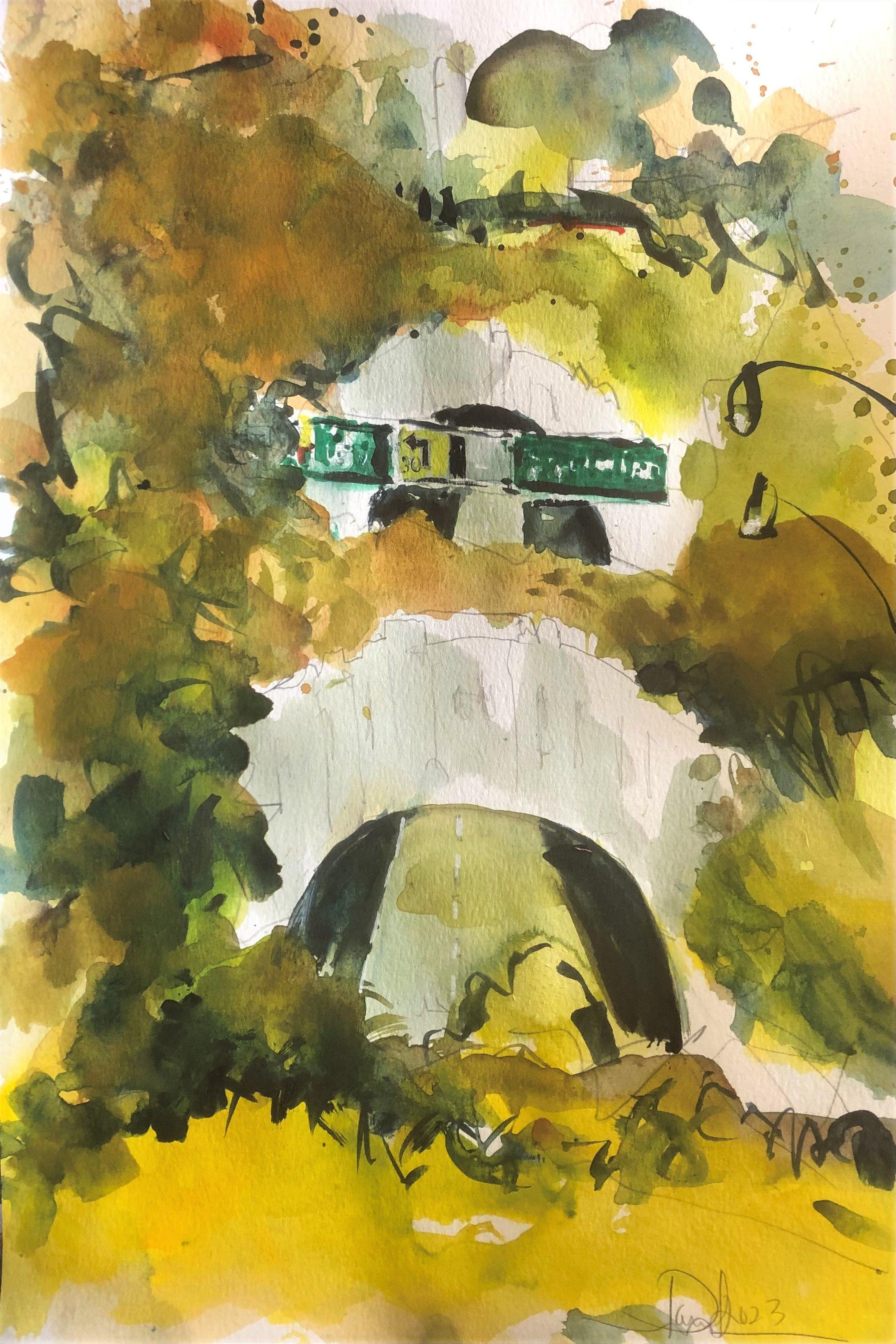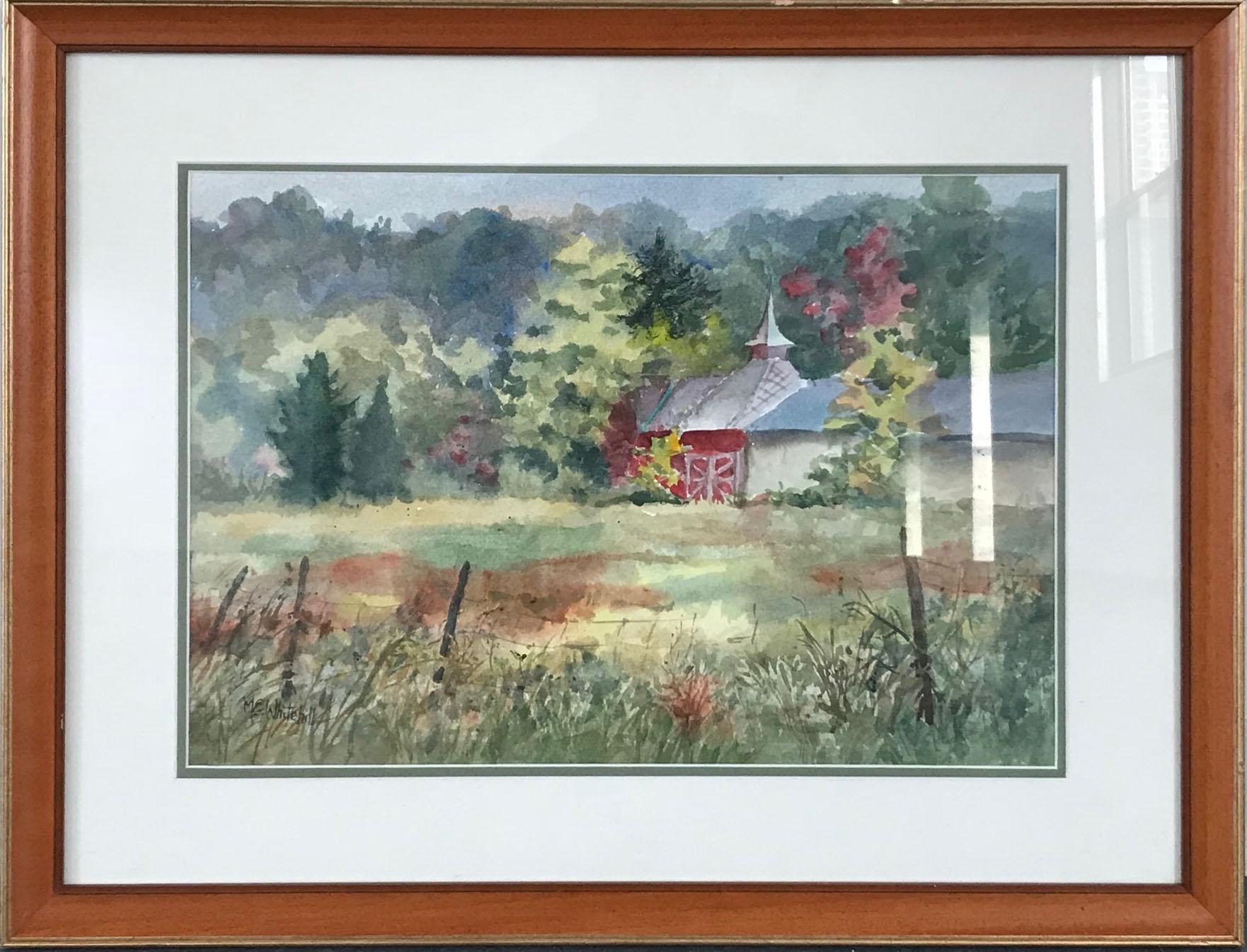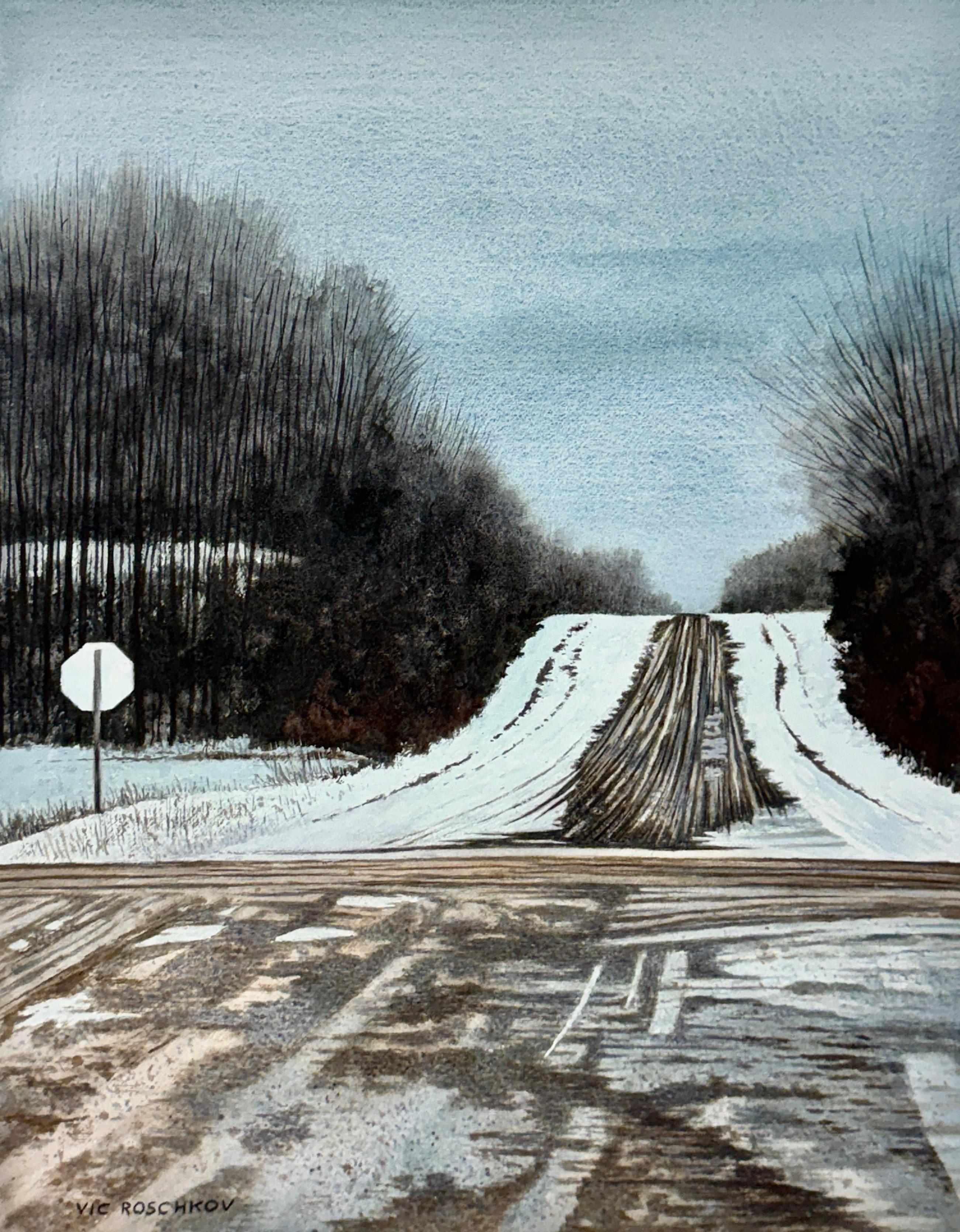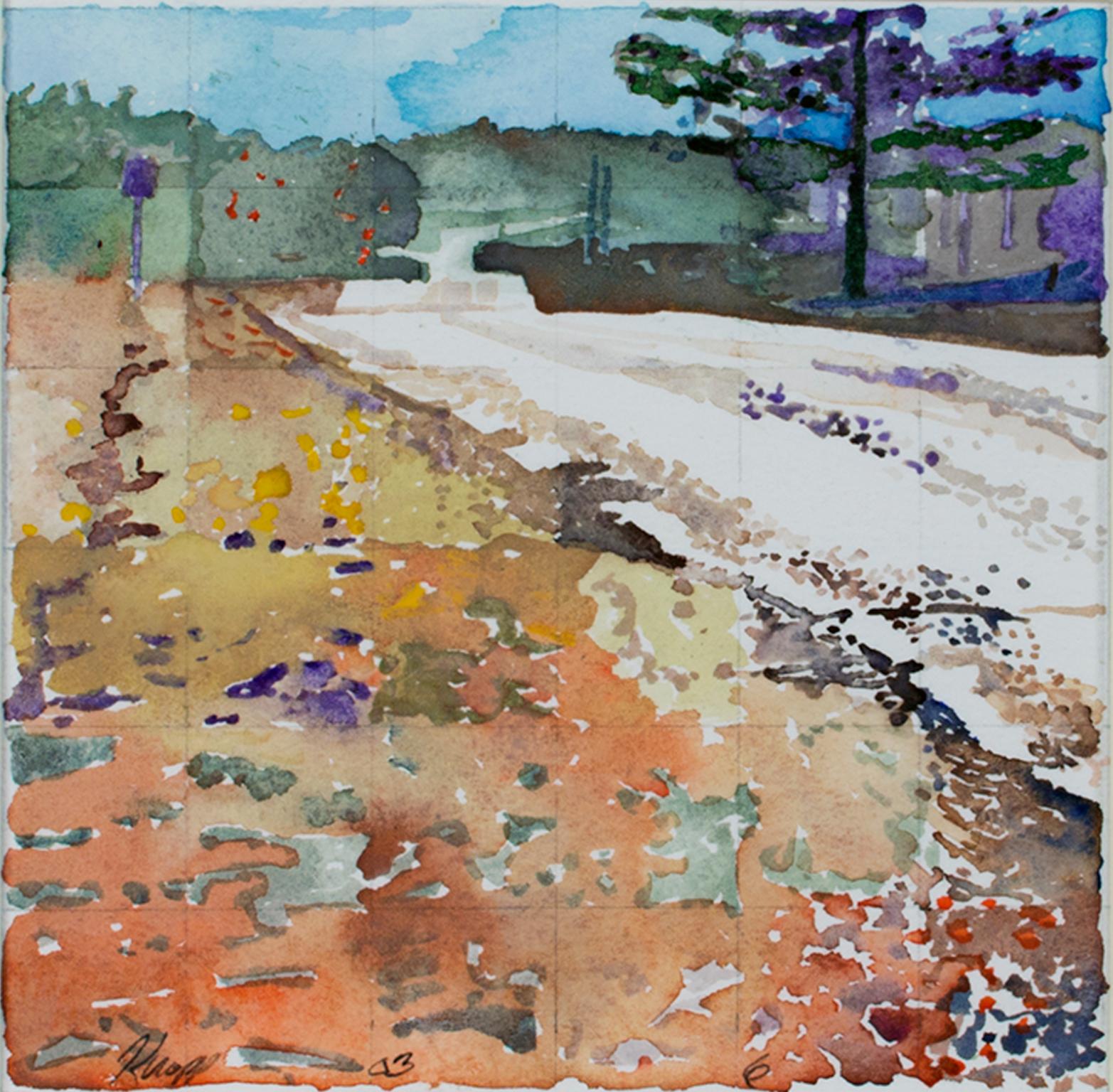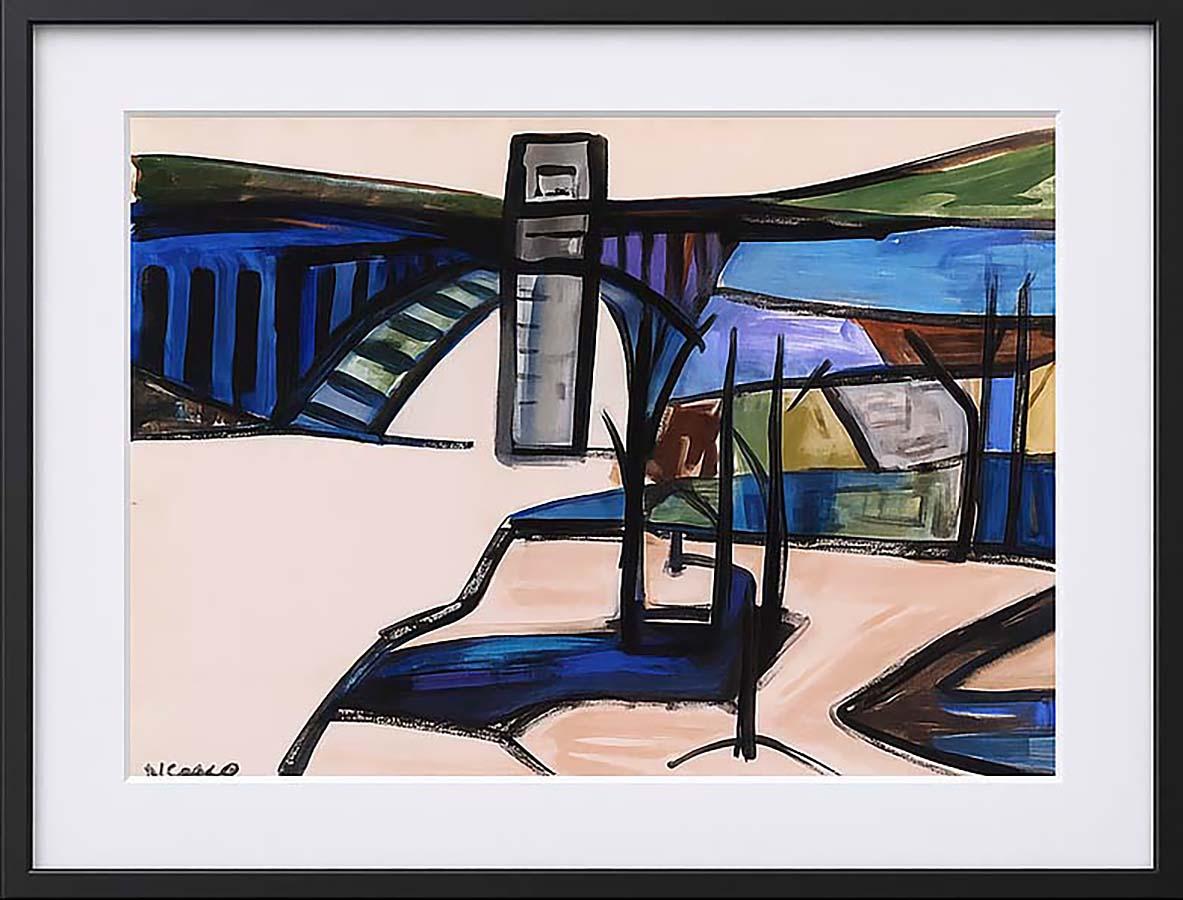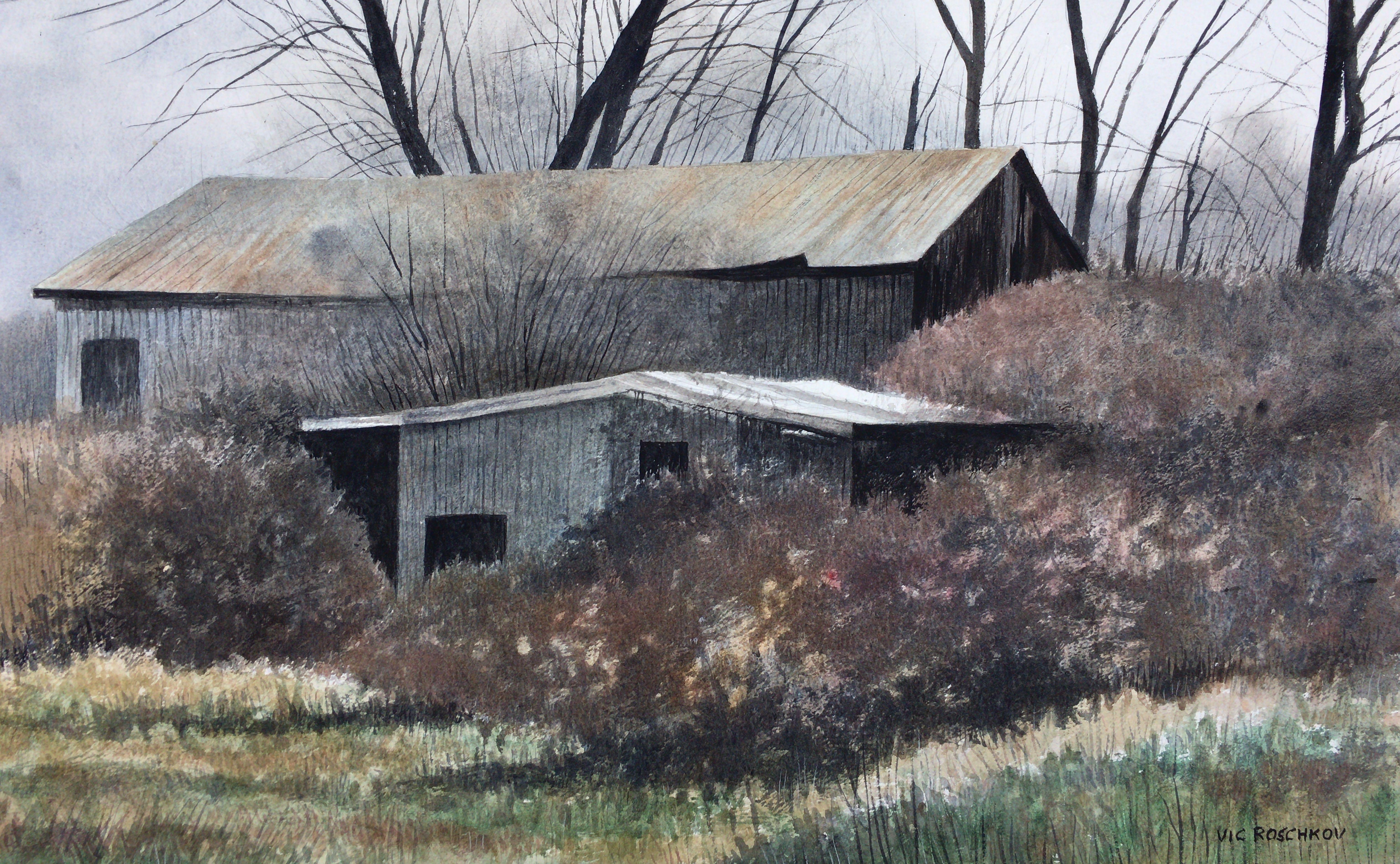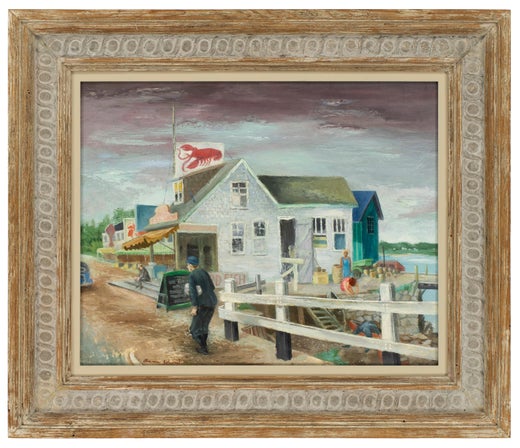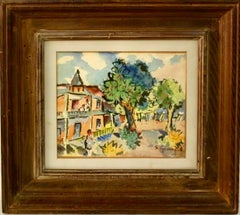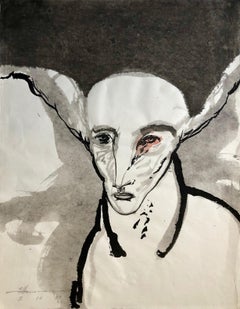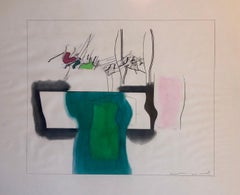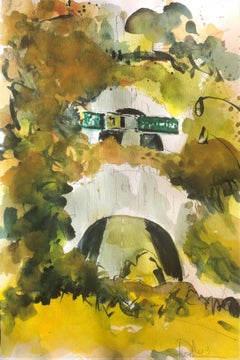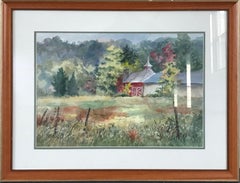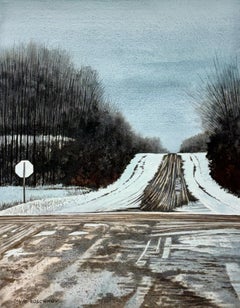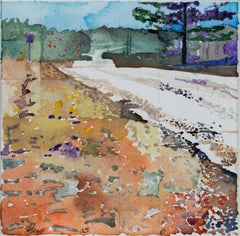Items Similar to Watercolor Painting Road Signs, Load Limit, Aaron Bohrod WPA Artist Chicago Art
Want more images or videos?
Request additional images or videos from the seller
1 of 14
Aaron BohrodWatercolor Painting Road Signs, Load Limit, Aaron Bohrod WPA Artist Chicago Art
$1,800
£1,352.21
€1,559.32
CA$2,497.73
A$2,775.53
CHF 1,454.41
MX$34,036.98
NOK 18,550.15
SEK 17,451.30
DKK 11,638.09
Shipping
Retrieving quote...The 1stDibs Promise:
Authenticity Guarantee,
Money-Back Guarantee,
24-Hour Cancellation
About the Item
Aaron Bohrod (1907-1992)
Listed Wisconsin WPA American Artist
Original Watercolor Painting
Hand signed "Load Limit Bridge"
Dimensions: 24"x18" inches
Aaron Bohrod (1907 – 1992) was an American artist best known for his trompe-l'œil still-life paintings. This one presages Pop Art with its depiction of road signs.
Bohrod was born in Chicago in 1907, the son of an emigree Bessarabian-Jewish grocer. Bohrod studied at the School of the Art Institute of Chicago and the Art Students League of New York between 1926 and 1930. While at the Art Students League, Bohrod was influenced by John Sloan and chose themes that involved his own surroundings.
He returned to Chicago in 1930 where he painted views of the city and its working class. During the Great Depression, Schwartz became an artist on the Federal Art Project (WPA) payroll painting murals. He was one of the seven WPA artists who contributed to a mural at Riccardo's, Schwartz (Music), Malvin Albright (Sculpture), Ivan Albright (Drama), Aaron Bohrod (Architecture), Rudolph Weisenborn (Literature), Vincent D’Agostino (Painting), and Ric Riccardo (Dance).
Many well known Jewish and Immigrant artists worked for the Federal Art's Project (the New Deal) commonly referred to as the WPA, including Berenice Abbott, William Baziotes, William Gropper, Ilya Bolotowsky, Stuart Davis, Adolf Dehn, Ben Shahn and Louis Schanker. In 2002 Chicago philanthropist Seymour H. Persky acquired the murals for his personal collection. He eventually earned a Guggenheim Fellowships which permitted him to travel throughout the country, painting and recording the American scene. His early work won him widespread praise as an important social realist and regional painter and printmaker and his work was marketed through Associated American Artists in New York. Bohrod completed three commissioned murals for the Treasury Departments Section of Fine Arts in Illinois; Vandalia in 1935, Galesburg in 1938 and Clinton in 1939. During World War II, Bohrod worked as an artist; first in the Pacific for the United States Army Corps of Engineers' War Art Unit, then in Europe for Life magazine. In 1948, he accepted a position as artist in residence, succeeding John Steuart Curry, at the University of Wisconsin–Madison, and remained in that capacity until 1973. In 1951, Bohrod was elected into the National Academy of Design as an Associate member, and became a full member in 1953. He showed at Associated American Artists (AAA) gallery in New York City Established in 1934 many major American artists showed there including Thomas Hart Benton, Georgia O'Keeffe, Peggy Bacon, Aaron Bohrod, John Steuart Curry, Luigi Lucioni, and Grant Wood. In the 1950s, Bohrod developed the trompe-l'œil style of highly realistic, detailed still-life paintings which give an illusion of real life. It was this style with which he became internationally identified.
Bohrod's works can be found in the collections of many American museums such as the Art Institute of Chicago, the Metropolitan Museum of Art, the Whitney Museum of American Art in New York, and the Hirshhorn Museum in Washington, D.C. The Aaron Bohrod Gallery at the University of Wisconsin–Fox Valley was named in his honor.
- Creator:Aaron Bohrod (1907 - 1992, American)
- Dimensions:Height: 24 in (60.96 cm)Width: 18 in (45.72 cm)
- Medium:
- Movement & Style:
- Period:
- Condition:
- Gallery Location:Surfside, FL
- Reference Number:1stDibs: LU38211934052
Aaron Bohrod
Aaron Bohrod's work has not been limited to one style or medium. Initially recognized as a regionalist painter of American scenes, particularly of his native Chicago, Bohrod later devoted himself to detailed still-life paintings rendered in the trompe l'oeil style. He also worked for several years in ceramics and wrote a book on pottery. Born in 1907, Bohrod began his studies at Chicago's Crane Junior College in 1925, and two years later enrolled in the Art Institute of Chicago. But it was at the Art Students League in New York City, from 1930 to 1932, that he studied under the man believed to be his most significant early influence, John Sloan. Sloan's romantic realism is reflected in the many depictions of Chicago life, which comprised most of Bohrod's early work. Under Sloan's tutelage, Bohrod came to subscribe to the belief that painters should find the subjects of their art in the immediate world around them. These paintings emphasized architecture unique to north Chicago and featured Chicagoans engaged in such everyday activities as working, playing or going to the theatre. The romantic aspect was conveyed by the use of misty colors, and the realism by attention to detail. In 1936, Bohrod won the Guggenheim Fellowship award in creative painting. It enabled him to travel the United States, producing similar regionalist paintings on a much broader range of subjects. Nevertheless, most of his early work centered on Chicago and the urban Midwest. In 1943, Bohrod was commissioned by editors of Life magazine to cover the battlefronts as a war correspondent and artist. Three years later, Bohrod was invited to become the Artist in Residence at the University of Wisconsin, a position that became vacant with the unexpected death of John Steuart Curry. He would remain at the University from 1948 to his retirement in 1973. Then, quite atypically, fantasy started to appear in his work. Elements of Surrealism, supposedly inspired by his concurrent involvement in ceramics with F. Carlton Ball, began influencing his landscapes. By 1953, Bohrod had completely ceased painting landscapes, turning instead to often symbolic still-life subjects. He abandoned his earlier romantic realism to paint in the luminous trompe l'oeil tradition of William Harnett. Bohrod continued to produce these meticulously crafted fantasies exclusively. While in his position at the University of Wisconsin, Bohrod painted covers for Time magazine and authored two books, A Pottery Sketch-book (1959) and A Decade of Still Life (1966), in which are produced many of his trompe l'oeil paintings.
About the Seller
4.9
Platinum Seller
Premium sellers with a 4.7+ rating and 24-hour response times
Established in 1995
1stDibs seller since 2014
1,782 sales on 1stDibs
Typical response time: <1 hour
- ShippingRetrieving quote...Shipping from: Surfside, FL
- Return Policy
Authenticity Guarantee
In the unlikely event there’s an issue with an item’s authenticity, contact us within 1 year for a full refund. DetailsMoney-Back Guarantee
If your item is not as described, is damaged in transit, or does not arrive, contact us within 7 days for a full refund. Details24-Hour Cancellation
You have a 24-hour grace period in which to reconsider your purchase, with no questions asked.Vetted Professional Sellers
Our world-class sellers must adhere to strict standards for service and quality, maintaining the integrity of our listings.Price-Match Guarantee
If you find that a seller listed the same item for a lower price elsewhere, we’ll match it.Trusted Global Delivery
Our best-in-class carrier network provides specialized shipping options worldwide, including custom delivery.More From This Seller
View AllEarly Drawing and Watercolor Painting Figurative Abstraction
By Mitch Becker
Located in Surfside, FL
Mitchell Mitch Becker, painter, born November 12, 1938, Chicago, Illinois. 1972, Emigrated to Israel.
Education
1961 - School of the Art Institute, Chicago, Illinois. Bachelor of Art Education,
1971 - University of Chicago, Chicago, Illinois, Master of Fine Arts,
Teaching
1968-1972 High School, Skokie, USA.
1973-1974 Thelma Yellin Art School, Givatayim
1974-1976 Institute of Visual Art, Beersheba
1977-1981 Art Teachers College, Ramat Hasharon
1981-1982 Bezalel, Jerusalem
Awards And Prizes
1958-61, Anna Tucson Scholarship, USA
Mitchell Becker emerged into the art world of late 1950s Chicago, between gestures of Abstract Expressionism and declarations about the "death of painting." The hot names of his youth, such as Willem De Kooning, Mark Rothko, and Larry Rivers, provided him with interest and challenges for years to come, and his awe for them is still evident in his voice to date, many years after drawing away from them. This work is reminiscent of the work of Saul Steinberg and Philip Guston.
Heroes - Past and Present, Yad Labanim Museum, Petach-Tikva
Artists: Shalom Moskowitz, (Shalom of Safed) Yohanan Simon, Boris Schatz, Motti Mizrachi, Hanan Milner, Mitchell Becker, Edith Samuel, Ludwig Schwerin, Igael Tumarkin, Talia Tokatly.
EDUCATION:
1971 Master of Fine Arts,University of Chicago, Illinois
1961 Bachelor of Art Education School...
Category
1960s American Modern Abstract Drawings and Watercolors
Materials
Watercolor
1940's Americana WPA Modernist Watercolor Painting Catskill Mountains Bungalow
By Samuel Grunvald
Located in Surfside, FL
Bungalow (fauvist painting of New York scene) 1940's.
image is 10X 11.5 inches. Hand signed lower right
Country Scene
Samuel Grunvald was a Hungarian born American WPA artist known for abstract, landscape and seascape paintings.
Arrived in the USA from Hungary in 1921 and settled in New York City where he studied at the Art Students League. Grunvald worked for the Federal Art Project, taught at Colony House in NYC. Member: Art Guild, Watercolor Society, New York Watercolor Club. exhibited at Montross Gallery, NYC, World House Galleries, NYC, Leonard Hutton Gallery, NYC, Associated American Artists Gallery and the A.C.A. Gallery. Gunvald's work spanned many modern American movements from the WPA to Abstract Expressionist painting. He was a member of the American Watercolor Society and the Brooklyn Society of Artists. He exhibited with both of these organizations and at the Brooklyn Museum of Art. He was involved the the WPA being a Federal Arts Project artist. A number of prominent Jewish artists participated in this New Deal program among them Ben Shahn, Joseph Solman, William Gropper, Philip Guston Adolph Gottlieb, Mark Rothko, Milton Avery, Ben Shahn, the Soyers (Isaac, Moses, and Raphael), and many others
Grunwald exhibited alongside other popular artists such as Paul Klee, Jean Arp, Max Ernst and Charles Burchfield. He also taught and lectured on art and easel painting, Federal Art Project, NYC. His work is included in the collections of the Museum of Modern Art and The Jewish Museum, New York. Americana.
The Catskills became a major resort destination for Jewish New Yorkers in the mid-20th century. Borscht Belt is an informal term for the summer resorts of the Catskill Mountains in Sullivan and Ulster counties in upstate New York which were frequented by Ashkenazi Jews. At its peak of popularity, about 500 resorts operated in the region. Later changes in vacationing patterns have led most of those travelers elsewhere, although there are still bungalow communities and summer camps in the towns of Liberty, Bethel, Monticello and Fallsburg catering to Orthodox Jewish populations. Borscht Belt, The term, which derives from the name of a beet soup popular with people of Eastern European origin, can also refer to the Catskill region itself.
In August, 1969, the Catskills were the site of a music and art festival in the town of Bethel, which had originally been planned for Woodstock, New York. Thirty-three of the best-known musicians of the era appeared during a sometimes rainy weekend in front of nearly half a million concertgoers. The event, featuring liberal drug use and nudity, exemplified the counterculture of the 1960s and 1970s.
Select Exhibitions
A.C.A. Gallery
Associated American Artists Gallery, 1936-1955
American Watercolor Society, 1932-1942
New York Watercolor Club, 1935-1937
Humanist Art...
Category
1940s Modern Figurative Drawings and Watercolors
Materials
Watercolor
Modern Figurative Surrealism Watercolor Painting, Drawing California Artist
By Gary Hansmann
Located in Surfside, FL
"The Sadness of Mr. lapin After the Artist Left"
Gary Hansmann (1947-2008) was active/lived in California. He is known for abstract, Surrealism figure painting.
Gary William Hansmann was born Dec. 4, 1940, in San Diego to Ethel May Williams and Lester Hughes Hansmann. He grew up in Encinitas and served in the Army in the early 1960s.
Gary Hansmann, San Diego artist, teacher and gallery owner, was known for his Surrealist nude and animal drawings and graphics. He spent time working in Paris and exhibiting his art throughout Europe, but San Diego was home until he moved to Washington state. His life partner was fellow artist, Jill Hosmer. Mr. Hansmann, a respected printmaker and prolific artist, created thousands of drawings, prints and paintings as well as hundreds of poems. His interest in bullfighting led to a book of poetry and illustrations on the subject, “La Corrida, The Run”, a collection of poetry & artwork written as he was preparing for his first bullfight. Prologue written by famous Mexican Matador Antonio Lomelin. The book is written in English and translated into Spanish on opposing pages and was published in 1983. Mr. Hansmann taught intaglio and monotype at the Academy of Fine Arts in San Diego from 1977 to 1980 and at the San Diego Museum of Art in 1980. He also gave lectures and demonstrations throughout the art community, including at the San Diego Art Guild in Del Mar and Artist Equity in San Diego. Although he attended Palomar College in San Marcos and studied lithography at the San Diego Academy of Fine Arts, Mr. Hansmann was mostly self-taught and self-educated. Mr. Hansmann had shows in several art-world capitals, including Paris; Lisbon, Portugal; Cologne, Germany; Brussels, Belgium; and New York. he had one-person exhibits at the Loft Gallery in Clarkston, the Lewis-Clark State College Center of Arts & History, the Carnegie Art Center in Walla Walla and the Valley Art Center in Clarkston. During his long, distinguished career as an artist he had numerous one-person exhibits all over the world and the United States.
His group shows are too numerous to mention, but his one-person exhibits were in Koln, Germany; Bruxelles, Belgium; Paris, France; Viana do Castelo, Portugal; Lisbon, Portugal; Tecate, Mexico; and British Columbia, Canada; and many states at home.
Palomar College, San Marcos, Calif.
San Diego Academy of Fine Arts
Brooklyn Museum, Brooklyn, N.Y.
University of Southern California, Idyllwild (ISOMATA)
University of San Diego
San Diego Museum of Art
James Copley Library, La Jolla, Calif.
Biblioteca Nazionale Marciana, Venice, Italy
Centre de Arte Moderna
Gulbenkian Foundation, Lisbon, Portugal
Museo Taurino de la Communidad de Madrid, Madrid, Spain
Atelier Lacouriere et Frelaut, Paris, France
Gordon Gilkey Collection
Portland Art Museum, Portland, Or.
Coos Art Museum, Coos Bay...
Category
1980s Surrealist Figurative Paintings
Materials
Paper, India Ink, Watercolor
Abstract MIxed Media Drawing Vibrant Modernist Color Watercolor Painting
By John Wood
Located in Surfside, FL
John Wood (b. 1945, Utah) is a Bay Area artist who currently resides in Emeryville, CA. He received his BFA in painting from the University of Utah in 1971, and an MFA from the Cranb...
Category
20th Century Abstract Mixed Media
Materials
Ink, Watercolor
Modernist Abstract Expressionist Watercolor Painting Bauhaus Weimar Pawel Kontny
By Pawel Kontny
Located in Surfside, FL
Abstract watercolor composition bearing the influence of the earlier color-block compositions of Paul Klee.
Pawel August Kontny, (Polish-German-American artist) He was born in Laura...
Category
20th Century American Modern Abstract Drawings and Watercolors
Materials
Watercolor, Archival Paper
American Woman Artist Society Doyenne Polly Kraft Large Watercolor Painting
By Polly Kraft
Located in Surfside, FL
Polly Kraft
American (1928-2017)
Umbrella Still Life (1984)
watercolor on paper
signed lower right
29 1/2 x 41 1/2 inches
frame dimensions: 33 x 45 1/4 x 1 1/2 inches, wood frame with acrylic glazing
Provenance: East Hampton Collection
Fischbach Art Gallery New York, NY label affixed verso
Polly Kraft, Known for painting portraits, landscapes, and still-lifes, realist artist Polly Kraft worked in both watercolor and oil. She had the ability to translate a split second glance into a memorable painting.a painter who turned quotidian objects and scenes — a sliced red apple still bearing its seeds, an unmade bed cluttered with mail, a filleted fish vibrant even in death — into works of art resonant with meaning, Her son, Mark Stevens is an art critic who with his wife, Annalyn Swan, co-authored the Pulitzer Prize-winning biography “de Kooning: An American Master”
Mrs. Kraft spent a half-century at the center of the Washington establishment as the wife of Joseph Kraft, the syndicated newspaper columnist, and later, after Kraft's death in 1986, of Lloyd Cutler, the high-powered lawyer who was White House counsel to Presidents Jimmy Carter and Bill Clinton. Her marriages took her into the thick and thicket of social life in the capital — a world, she once remarked, where "politicians were mixed in with intellectuals, mixed in with academics, mixed in with movie stars." She counted among her friends members of the Kennedy family, former Washington Post chairman and publisher Katharine Graham, former Post executive editor Benjamin C. Bradlee and diplomats W. Averell and Pamela Harriman.
Although oft cited as a doyenne of Georgetown hostesses, Mrs. Kraft professed that she relished neither politics nor Washington’s breed of socializing, which at times approached the intensity of a competitive sport.
“When it comes to the poetry of dishevelment, Polly Kraft is one of our more rewarding practitioners,” art critic John Russell wrote in the New York Times in 1981. “She specializes in the domestic pileup — cushions knocked out of shape, books and magazines left askew, hasty departures acted out in verismo style. The point of the paintings lies in the contrast between this archetypal havoc and the order that Mrs. Kraft has imposed upon it.” Classic Americana.
Her paintings, mainly watercolors and oil paintings, appeared at venues including the Corcoran Gallery of Art and Addison/Ripley Fine Art in Washington (she was part of their 40 year retrospective along with
Lou Stovall, Diana Walker...
Category
20th Century Figurative Drawings and Watercolors
Materials
Watercolor
You May Also Like
110 Northbound!, Painting, Watercolor on Watercolor Paper
By Daniel Clarke
Located in Yardley, PA
Pasadena Freeway 110 departing Los Angeles and headed for Pasadena thought the underpasses. Walking through a freeway tunnel, Getting hit by all the cars, The memories crash int...
Category
2010s Impressionist Drawings and Watercolor Paintings
Materials
Watercolor
Untitled Watercolor : In the Country
Located in New York, NY
Mary Evelyn Whitehill (American) "Untitled Watercolor: In the Country", Impressionist/Landscape Watercolor Painting Framed and Signed on Paper, ...
Category
Late 20th Century Impressionist Landscape Drawings and Watercolors
Materials
Watercolor
Middle of Nowhere, Original Painting
Located in San Francisco, CA
Artist Comments
A wintry country road stretches into the distance, evoking a sense of serenity and isolation. Bare trees and snow-covered fields frame the scene. Tire tracks ...
Category
21st Century and Contemporary Realist Landscape Drawings and Watercolors
Materials
Watercolor
Contemporary landscape watercolor road gravel trees sky signed
By Kevin Knopp
Located in Milwaukee, WI
"Road I Travel #6" is an original watercolor on paper by Kevin Knopp. The artist signed and dated the piece lower right. This piece features a dirt and gravel road.
6" x 6" art
13"...
Category
Early 2000s Contemporary Landscape Drawings and Watercolors
Materials
Watercolor
Watercolor Painting American Modern Painting Bridge Harbor Female Artist 1950
Located in Buffalo, NY
Dorothy Rivo
Untitled (Bridge Tower), c. 1960s–70s
Acrylic on paper, floated in a mat
Framed dimensions: 30 in. H × 24 in. W
Contemporary walnut or black wood frame with white archiv...
Category
1940s American Modern Landscape Drawings and Watercolors
Materials
Archival Ink, Watercolor, Archival Paper, Acrylic
Out of the way, Painting, Watercolor on Watercolor Paper
By Victor Roschkov
Located in Yardley, PA
An abandoned old barn hidden away somewhere out in the country. :: Painting :: Realism :: This piece comes with an official certificate of authenticity signed by the artist :: Ready ...
Category
2010s Realist Drawings and Watercolor Paintings
Materials
Watercolor
